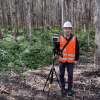
PFT's 2021-22 Annual Report now available to review
Posted 27 October 2022
Private Forests Tasmania is pleased to present the 2021-22 Annual Report, officially tabled in Parliament on October 27 by Minister for Resources, Felix Ellis.
This year has seen the development of a new three-year strategic plan for Private Forests Tasmania with refreshed goals and strategies to reflect the changing priorities and challenges facing the private forest sector.
Developed through extensive consultation with private forestry stakeholders, our four key strategic goals include:
- Working creatively and collaboratively with partners and stakeholders to improve private native and plantation forestry commercial wood supply and carbon outcomes.
- Effectively communicating the benefits of private native and plantation forestry as an integral part of Tasmania’s agricultural growth strategies.
- Working with government policy makers and regulators at local, state, and national levels to improve regulatory efficiency and practical policy settings for private native and plantation forestry.
- Building organisational capacity by developing our people, knowledge, safety, systems, culture and funding resources.
The annual report outlines PFT’s achievement in each of these areas throughout 2021-22.
Six priority projects were identified and are reported on in detail in this annual report, which will continue into the next reporting period.
Priorities were particularly focused on alleviating Tasmania’s wood supply shortages with a major focus on our Tree Alliance marketing campaign to develop partnerships and alliances to educate, encourage and facilitate integration of commercially viable trees into the Tasmanian agricultural landscape. This long-term strategy aims to grow our future economy and ecology through trees.
Through joint state and federal funding, PFT has developed and executed its second round of demonstration sites - our Trees on Farms program, adding a further eight properties to the seven sites established in 2020-21, which will result in an additional 329 hectares of mixed shelterbelts and woodlots established throughout the state.
The private forest harvest reports 3.88 million tonnes of logs to market from the privately owned forest estate, an increase of 0.41 million tonnes which made up 73.6 per cent by volume of the state’s total production.
PFT looks forward to continuing to deliver on our statutory objectives and assist the sector in expanding and developing the private forest resource in Tasmania in the 2022-23 financial year.
Share this Article
Latest Articles
-

17 September 2025
Celebrating excellence at the Tasmanian Timber Awards
-

17 September 2025
Forest Practices Authority Research Update Day
-

13 August 2025
Have you seen our Stems for CO2 Project signage on the Midlands Highway?
Archives
- ActivAcre hits milestone, calls for more farmers to get on board
- Napier's leading the way in sustainable forestry and carbon-neutral farming
- Sound science needed to assess carbon impacts of timber harvesting
- Newly appointed TFFPN Board of Directors
- Graduate Certificate of Forestry Scholarship
- Forestry Australia Mentoring Program 2025
- Forest Industry Roundtable planning for the long term
- Eagle Management Constraint Period extended
- Successful private native forest management celebrated
- $15 million investment in new ship loader to boost Bell Bay's forestry exports
- Standing with Tasmania's forestry industry: buy local
- TFPA: Tasmanian Freight Equalisation Scheme needs a ground-up review
- AFCA Gala Dinner celebrates industry excellence
- Fire permits now required Statewide
- Forest leaders hone skills in sustainable native regrowth management
- Tasmanian forests and the carbon market: Barriers and opportunities
- Spring is the time for fuel reduction burning
- Primed for Growth: A situation analysis of the Tasmanian Forest and Wood Products Sector
- Audit requirements cut for low-risk plantation projects
- Guidance and support for landowners after damaging winds
- Forestry Australia welcomes further definition of active forest management
- Farm & Forest Mapper Tool highlighted at Rural Youth Tasmania's Young Farmer of the Year competition
- Senate Select Committee inquiry into the Tasmanian Freight Equalisation Scheme
- Timberlink announces new wood composite products brand
- Newly developed protocol a vital tool for safeguarding forestry industry
- Red Hot Tips: Fire management for Tassie farmers
- Bioenergy: Fuelling industries with trees
- Harvesting trees: What you need to know
- Shelterbelts: How are they contributing to farm systems?
- Infill plantings and remnant vegetation: Why biodiversity depends on a thriving understory
- Plantation planning: The key to a successful plantation
- Exciting interactive forestry knowledge hub launched
- $450,000 farm forestry grant recipients revealed



